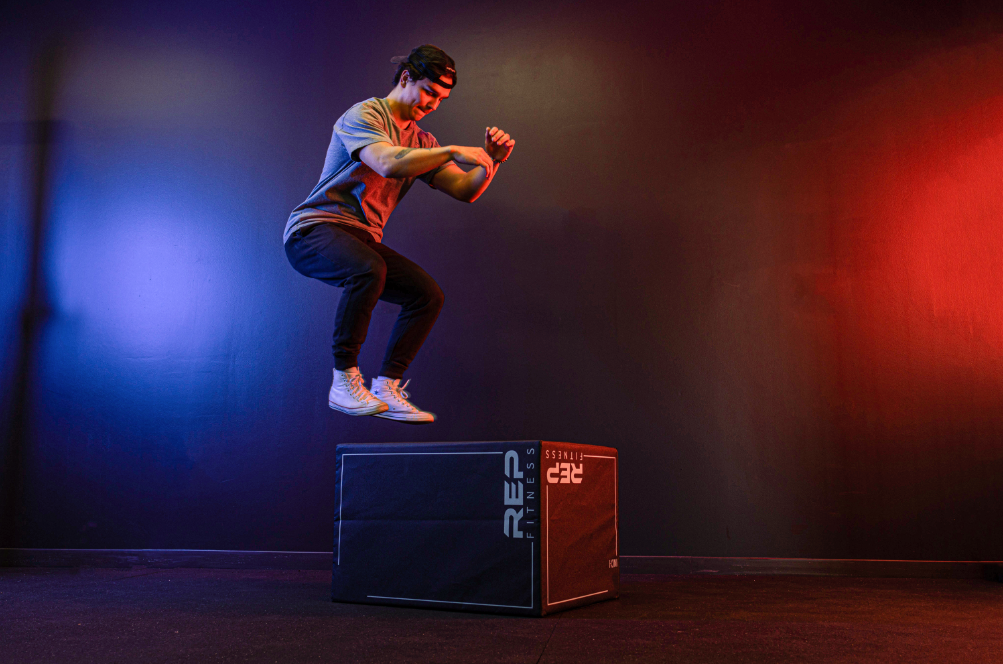
Try this box of tricks on your box jumps.
It seems to happen in slow motion. You wind up. You jump. You come in just a littttttle short. And <insert gagging noises> -- your shins greet the edge of the box with their skin.
Missing a box jump is one of the worst feelings in the gym. Maybe in the world. It sucks so bad it can keep well-intended athletes from attempting box jumps altogether.
But box jumps are beneficial, darn it. So, there’s got to be a way to incorporate them into your workout without shaving off the top layer of your shin skin.
Here’s the lowdown.
Benefits of Box Jumps
First, the why.
No matter how scary, if your health allows, you don’t want to avoid the boxes. Box jumps can help you improve your speed, power, strength, endurance, stamina, and coordination. Plus, they burn a ton of calories.
Read more here about why you might want to add a Plyo Box to your home gym. This article also dives into the different types of boxes out there.
Tips for Box Jumps

How hard can it be? You just jump up and land on top of the box. Right? We all wish. Box jumps aren’t as easy as they look. Here are some tips and progressions to make you the king or queen of the box.
Drop the height.
This is especially helpful if you have a mental block or fear holding you back. Drop the height of your jump. Stackable plyo boxes start as low as 4”.

Or you can even practice jumping on top of a bumper plate. A 45lb Black Bumper Plate is 2.8” tall.
Practice until you feel comfortable and confident, and slowly increase the height bit by bit. This is where stackable plyo boxes can be especially helpful. Progress from 4” to 6”. Put those two together to make 10”. Then graduate to 12”. Keep building.
You can also stack plates on top of each other, although that’s less stable. The stackable boxes attach via heavy-duty Velcro flaps on all four sides and have a wide base to land on. Plus, the soft foam will save your shins (and reduces impact).
Perfect step-ups.

Another way to build confidence and strength on the box is with step-ups. Skip the jumping altogether, and practice stepping up and down, one foot at a time. This gets you used to the box and still helps you build muscle, stability, and comfort that will help translate into jumps. Over time, add weight for more of a challenge.
Do squat jumps.
Step-ups may build confidence, but you also need to train explosiveness. You can practice this on the ground with squat jumps. Over time, add weight with a weighted vest, sandbag, or dumbbell.
Train drop jumps.
Drop jumps are all about perfecting your landing, which is half of the exercise. Start on top of your box and step off, landing with your feet about shoulder-width apart and the knees soft. Immediately move into a squat jump. It’s like a squat jump, but adding in the box jump landing (and momentum from the drop).
Incorporate tuck jumps.
A big part of a box jump is tucking your knees to your chest and exploding from the floor. Tuck jumps help you practice that without the added equipment of a box. Jump from the ground, tucking your knees tight, and try to get as high as possible.
Practice kneeling jumps.
You can also strengthen your hip flexors and tucked position by doing kneeling jumps. This will especially benefit high box jumps. Start on your knees on an exercise mat. Explode into a squat position. As you improve, you can add weight to these.
Start with a foam box.
When you’re ready to take it to the box, start with a padded box over a wooden one. The 3-in-1 Soft Plyo Boxes and Stackable Soft Foam Plyo Boxes feature ultra-dense foam that protects your shins and joints by absorbing impact. The foam also adds weight to the box, making it highly tip-resistant, even when you land on the edge. They’re covered in protective, heavy-duty vinyl.
Focus on your landing.
Perfect your landing on top of the box before you move to a higher level. This will keep you safe and injury-free. Make sure both feet land at the same time and your knees are straight and not caving in toward each other.
Train unilaterally.

We all have one side of the body that’s stronger than the other. Work on balancing that out by doing unilateral movements, like single-leg squats and working up to single-leg box jumps (start low and work your way up).
Build your glutes.
Strengthening your legs, in particular your glutes, can help your box jumps. Hip thrusters and other hip hinge motions (like deadlifts) help build power that will beef up your jumps. Squats are also great.

Also, do exercises that strengthen your calves, like calf raises and jump rope.
Make sure you’re using good form.
Proper technique will make your box jumps go better – and keep you from getting hurt.

Some tips:
- Start with your feet about shoulder-width apart.
- Stand one to two feet away from the box.
- Swing your arms forward as you jump.
- Imagine pushing into the ground.
- Tuck your knees when you jump.
- Try to land with the same form as your starting position: feet the same distance apart, equally on both feet and at the same time.
- Land on the balls of your feet first.

NEWSLETTER SIGNUP
Product launch information, promotions, blogs, and REP news.







